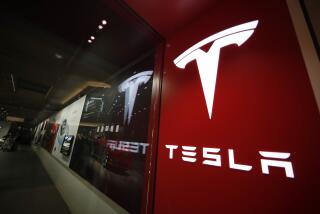
The electric vehicle market is steeped in uncertainty. EV sales growth has slowed; automakers are pulling back on EV production; politics around the subject is growing nasty, as the very idea of driving an EV has entered the culture wars.
But one analyst says don’t fret: “Our long-term outlook for EVs remains bright.”
That’s according to market researcher BloombergNEF, which released the 2024 version of its annual electric vehicle outlook report on Wednesday.
Aggressive and impactful reporting on climate change, the environment, health and science.
In 2023, EVs made up 18% of global passenger-vehicle sales. By 2030, according to the report, 45% will be EVs. That number jumps to 73% by 2040 — still short of what the world needs to reach net zero emissions in transportation, the firm says, but enough to achieve major reductions in climate-changing carbon emissions.
The long-term outlook adds a bit of glow to more recent news, especially in the U.S. and in California, where an EV sales slowdown, led by Tesla, has spanned two quarters, challenging the state’s climate goals.
A global survey conducted by consulting firm McKinsey, also released Wednesday, included this shocker: 29% of EV owners told McKinsey they plan to replace the EV they bought with a gasoline or diesel car, a figure that jumps to 38% for U.S. EV owners.
Phillip Kampshoff, who leads McKinsey’s Center for Future Mobility in the Americas, said he’d seen EV sales as “a one way street. Once you buy, you’re hooked on an EV. But that’s not what the data shows.”
Under a 2020 edict by Gov. Gavin Newsom, auto manufacturers must phase out California sales of new fossil fuel cars between now and 2035, when only what the state calls “zero-emission vehicles” will be allowed. (The mandate allows 20% of those vehicles to be plug-in hybrids, which can run on fossil fuels.)
Eleven other states are following California’s lead, although Virginia’s Republican governor plans to drop out by year’s end.
In the U.S., hard-knuckle politics are affecting consumer attitudes toward electric vehicles, as presidential candidate Donald Trump and his supporters in Congress have turned government regulations on emissions technology into a red meat issue for MAGA conservatives. Or, as BloombergNEF more gently puts it: “In the U.S., market jitters inflamed by upcoming presidential elections helped slow down adoption this year.”
Beyond politics, the road to EV growth is chock full of hazards, and different countries are moving at different speeds and with different levels of commitment.
Today, “China, India and France are still showing signs of healthy growth, but the latest data from Germany, Italy and the U.S. is more concerning,” BloombergNEF said. Global EV sales “are set to rise from 13.9 million in 2023 to over 30 million in 2027,” despite the lagging U.S.
Whatever the geography, consumer concerns about price, driving range, battery lifespan, and unreliable public charging continue to dampen many buyers’ enthusiasm for EVs. BloombergNEF’s findings are echoed by consulting firm McKinsey and the AAA motor club, in recent forecasts of their own.
But EV prices are coming down, range is improving, and large numbers of public chargers are being installed, all of which could revive sales growth.
California has ambitious climate goals, including a pledge to ban the sale of new gasoline- and diesel-powered cars and light trucks by 2035.
Intent to buy
Consumers around the planet are warming to the idea of buying an electric car, but they’re moving slowly. According to McKinsey, 14% of 30,000 global survey respondents in 2021 said their next vehicle would be an EV. This year, it’s 18%.
In the U.S. it’s a different story, where consumer interest in an EV purchase declined to 18% this year, according to AAA’s survey, down from 23% in 2023. And nearly two-thirds reported they were unlikely to buy an EV next time they buy a car.
Interest in hybrids is on the rise. One in three said they were likely to buy a hybrid, a vehicle that adds a small battery to an internal combustion engine to improve fuel efficiency.
That’s bad news for pure EV sales, at least in the immediate future, said Greg Brannon, head of automotive research at AAA. Early adopters already have their EVs, he said, while mainstream buyers remain skeptical.
Tesla’s sales decline, overcapacity and price cuts, plus the antics of Chief Executive Elon Musk, bode ill for the U.S. market as a whole. “Tesla is a leading indicator of what’s happening in the EV market,” Brannon said. “When we see softening at Tesla, we see softening across the board.”
Major automakers are losing billions of dollars in their EV divisions. Tesla, Mercedes-Benz, General Motors and Ford have all cut back their EV goals for the U.S., at least temporarily. Companies such as Hyundai and Kia, however, aren’t retreating. The market is moving from early adopters to “early majority customers,” Kia CEO Ho Sung Song told Automotive News.
“Once we start going into early majority customers, the speed of transitioning to electrification will be fast,” Song said. “Our commitment remains resolute.”
Non-Tesla EV drivers will want to double-check their routes before planning a road trip that relies on the Supercharger network. Not all California locations are open to other makes of EVs yet.
Global markets
In China, India, and even in France, the picture’s different. China is the world’s largest seller of automobiles of any type, including EVs. The country has managed to make EVs far cheaper than carmakers in the U.S. and in Europe, and they’ve begun a big export push. (The Biden administration is slapping a 100% tariff on China-made EVs to protect domestic manufacturing.)
For the first quarter in China, EV sales were up 37%, according to BloombergNEF. In India, it’s 39%, and in France, 20%. The U.S. was a laggard, up just 4%.
A flood of cheap Chinese electric car exports has raised the specter of another trade war with the U.S. And it has Tesla worried.
Gliding on the S curve?
Both BloombergNEF and McKinsey said that EV sales appear to be on the flat part of what’s known in business circles as the S curve. Sales of a popular new technology take off fast among early adopters, then glide along flat for awhile as mainstream customers mull their options, and then shoot up again if the mainstream buys in.
McKinsey’s Kampshoff said he personally believes the mainstream will get on board — but maybe not as aggressively as the industry once hoped. The consulting firm has reduced its growth projections for 2030 by 15% to 20% he said.
Still, “while we expect slower adoption, overall, we’re still pretty bullish.”
A proposal to amend California’s Constitution to enshrine environmental rights for all citizens has been delayed for at least another year.












